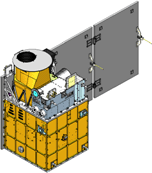닫기
| 인공위성연구센터 소개 | 인공위성관련 정보 | 연구개발 | 인력 양성 | 연구개발시설 | 산업기술지원 | 정보나눔 |
|---|---|---|---|---|---|---|
|
인사말 설립목적과 비전 연혁 조직도 찾아오시는 길 |
인공위성소개 - 인공위성 개요 - 주요 임무 - 내부구조 - 위성체조립 - 환경시험 - 발사 위성개발역사 |
우리별 위성 개발 - 우리별 1호 - 우리별 2호 - 우리별 3호 과학기술위성 개발 - 과학기술위성 1호 - 과학기술위성 2호 - 나로과학위성 - 과학기술위성 3호 차세대 소형위성 개발 초소형위성 군집시스템 개발 핵심우주기술 개발 - 다기능 구조체 - 고성능 탑재컴퓨터 개발 - 홀 추력기용 연료공급장치 - 리튬-이온 배터리 - 초소형 영상 분광기 - 고속데이터 시뮬레이터 과거수행 프로젝트 |
캔위성 체험·경연대회 뉴스페이스 리더 양성 - 사업 개요 - 사업 운영 - FAQ |
지상국 청정실 진동시험기 열진공 챔버 |
환경시험지원 - 진동시험 - 열진공/주기시험 |
공지사항 채용공고 사진자료실 |
| 전체메뉴닫기 | ||||||

Research and Development
NEXTSat-1
▶ HOME > Research and Development > NEXTSat-1

∎ NEXTSat-1
The project aims to develop a 100kg-grade next-generation small satellite to conduct scientific missions, verify core space technologies and develop new space technologies. It will be the first in the small satellite series developed under the objectives of miniaturization, modularization and standardization. Together with the talent development program aimed at training professionals to implement the Medium-term Space Development Plan, the project plays a central role in national space development.- To develop the next-generation small satellite series and new technologies by creating a standardized platform for
small satellites based on miniaturization, modularization and standardization.
- To conduct in-orbit verification of core space technologies that will enhance domestic space capabilities and enhance
technological competitiveness for import substitution.
- To develop space technologies and enhance independent space development capabilities through geo-environmental
monitoring and astronomical observation
- Hands-on and customized development of researchers and scientists through field experience in space technologies
and science
| Objective | Plan |
|---|---|
| MIniaturization |
• Maximization of payload capacity through miniaturization of the satellite structure - Payload percentage in satellite weight : 40%~50% - Satellite weight : Approximately 100kg • Development of eco-friendly propulsion system which can be deployed selectively according to mission requirements |
| Standardization |
• Standardization of electrical and mechanical connection conditions to support various missions • Set development standards for performance requirements such as lifespan, attitude pointing precision etc that vary between missions and develop as optional specifications |
| Modularization | Design modular payloads for the stable operation of the main body |
| Low Power Designl | Implement low power design by considering the power requirements of the respective technology verification payloads |
| Item | Development Parameters | Note |
|---|---|---|
| Operation Orbit (km) | 650 ~ 800 | Sun-synchronous Orbit (SSO) |
| Weight (kg) | Approx. 100 | |
| Volume (mm) | 578 × 598 × 923 | Not including adaptor height |
| Mission Length (Years) | 2 | |
| Attitude Control Method | 3-axis stabilization | |
| Power (W) | 250 | As of mission completion |
| Bus Votage (V) | +24 ~ +32 | Primary source+28V supply |
| Communication Bus | CAN Bus | SOH |
| Bus-Payload Communication | Serializer/Deserializer LVDS | < 100 Mbps |
| Satellite Control Frequency | S-band | Satellite status information |
| Observation Data Frequency | X-band | Payload |
| Type | Payload |
|---|---|
| Scientific Mission | Instrument for the Study of Space Storms(ISSS) |
| Near-Infrared Spectrometer for Star Formation History(NISS) | |
| Core Space Technology Verification |
Next-generation High Speed Data Storage(SDR-10) |
| 5 mNm-grade Reaction Wheel Assembly(RWA) | |
| 3 Dimensional Mass Memory적(3DMM) | |
| S-band TCTM Digital Transponder(SDT) | |
| Standardized On-board Satellite Computer Module (OBC) | |
| Space-grade Fiber Optic Gyro (FOG) | |
| FM-grade high speed/high precision Star Tracker (STR) |


